Comments / Questions (166)
![]() Dorte Ølsgaard wrote:
Dorte Ølsgaard wrote:
Findes der nogle mål et sted ? Vil gerne vide ca. omkreds på de store størrelser
29.05.2025 - 13:34DROPS Design answered:
Hei Dorte. Du finner målskissen med cm mål nederst på oppskriften. mvh DROPS Design
02.06.2025 - 10:25
![]() Anne Dochweiler wrote:
Anne Dochweiler wrote:
Viser foto poncho strikket med en type garn eller to. Den ser for mig ud, som lidt tykkere end en tråd. Jeg har svært ved at vurdere, om jeg skal vælge 2 tråde! Kunne den evt strikkes med 2 tråde af det låne? På forhånd tak.
26.05.2025 - 16:26DROPS Design answered:
Hej Anne, du kan med fordel strikke den i 2 tråde. Se alle kombinationer her med samme strikkefasthed på 15 masker = 10 cm : Garnkombinationer med 14-15 masker på 10 cm
27.05.2025 - 14:51
![]() Inge Jensen wrote:
Inge Jensen wrote:
Jeg har strikket Hometown drops poncho, men målet fra krave kanten og ned hvor ærme/ribkanten er det eneste mål der ikke passer. Indtagning 2 er der 3 cm imellem. Ærmeomkredsen passer også. Målet, som ikke passer siger den skal være 51 cm men er 10 cm for kort. Kan i hjælpe?
03.04.2025 - 17:08DROPS Design answered:
Hej Inge, hvis du har fulgt ind og udtagninger ifølge din størrelse, så må det være noget med strikkefastheden i højden. Hvis du feks har 2 pinde extra for hver 10 cm, vil du nå antal masker tidligere end du vil nå målet. Kan du evt fortsætte med ribkanten?
08.04.2025 - 14:16
![]() Sissel Askeland wrote:
Sissel Askeland wrote:
Hei igjen.Jeg tente på Big Merino uni coulor.Hvor mye gar trenger jeg?Det skak være 500 gram Alpacka inkludert med armer og hals til denne ponchoen.Det er bare 50 m.på nøstene med Big Merino uni colour.
17.03.2025 - 12:50
![]() Sissel Askeland wrote:
Sissel Askeland wrote:
Hei Kan jeg bytte garn til Baby merino sammen med kid silk til denne ponchoen.Må ha mykt garn siden Alpakka klør på huden min.
16.03.2025 - 15:47DROPS Design answered:
Hei Sissel, I oppskriften er det foreslått et garn fra garngruppe A og et garn fra garngruppe C. Du foreslår 2 garn fra garngruppe A som blir en tynnere blanding. Prøve å bytte ut et av garnene dine med et fra garngruppe C. Da har du samme tykkelse. Vi alltid anbefaler at du strikker en prøvelapp før du begynner, for å sjekke strikkefastheten din. God fornøyelse!
17.03.2025 - 08:03
![]() Anita Pasricha wrote:
Anita Pasricha wrote:
When you say leave front piece aside. Is it one the same circular needle? Pls explain
19.01.2025 - 12:48
![]() MARIE LAURE MICHARD wrote:
MARIE LAURE MICHARD wrote:
Bonjour je comprend pas j ai commander exatement la quantite de laine soit 4 pelotte de alpaca silk et 10 alpaca et je suis au milieu de mon tricot et je n ai plu alpaca silk il fallait bien tricoter les deux ensemble ?
27.11.2024 - 20:39DROPS Design answered:
Bonjour Mme Michard, pour 10 pelotes de la laine Alpaca (50 g chacun = 500 g au total), il faut ajouter 7 pelotes de Drops Brushed Alpaca Silk (chaque pelote a 25 g, 25x7=175 g). Bon tricot!
28.11.2024 - 09:03
![]() Maureen wrote:
Maureen wrote:
I made it and absolutely love it. The pattern was very well written. I get compliments every time I wear it.
13.10.2024 - 14:17
![]() Petra wrote:
Petra wrote:
Hallo, ist es richtig, dass ich nach der Krausrippe in JEDER Reihe am Anfang UND am Ende der Reihe die 2 Maschen (9x) zunehmen muss (insgesamt. 18 neue Maschen auf jeder Seite). Also in der Hin- UND der Rückreihe, d.h also nicht nur auf der Vorderseite. Herzlichen Dank
03.09.2024 - 14:47DROPS Design answered:
Liebe Petra, nach der Krausrippe stricken Sie mit 1 Faden Snow (nicht mehr mit Polaris) weiter und nehmen Sie mit 1 Umschlag nach jeder re. Masche zu; nach 5-6-7 Runden rechts stricken Sie wieder mit Polaris und stricken Sie alle Maschen rechts zusammen, so wird das Rüschenmuster gestrickt. Viel Spaß beim Stricken!
04.09.2024 - 08:26
![]() Maria Angeles wrote:
Maria Angeles wrote:
Me gustaría mucho saber hasta pronto pero no me lo saben explicar en ninguna tienda que voy a comprar
03.03.2024 - 14:40DROPS Design answered:
Hola Maria Angeles, si vas a una tienda DROPS (https://www.garnstudio.com/findastore.php?id=23&cid=23) y enseñas la lista de materiales indicadas en la parte superior podrán ayudarte o posiblemente encargarte lanas. El texto del patrón está disponible aquí online.
03.03.2024 - 23:34
Hometown |
|
 |
 |
Knitted DROPS poncho in 1 thread ”Symphony”, 1 thread "Melody" or 1 thread "Brushed Alpaca Silk" + 1 thread "Alpaca" with rib in ”Alpaca”. Size S to XXXL.
DROPS 123-28 |
|
|
GARTER ST (back and forth on needle): K all rows. DECREASING TIP 1 (applies to mid front and mid back): Dec from RS each side of 2 sts. Dec as follows 3 sts BEFORE marker: K2 tog, K1. Dec as follows AFTER marker: K1, slip 1 st as if to K, K1, psso. DECREASING TIP 2 (applies to the side): Dec by K2 tog before marker and K2 tog into back of loop after marker. -------------------------------------------------------- PONCHO: Worked in 2 parts, then parts are put tog and piece completed in the round on all sts. Arrows in diagram show the knitting direction. BACK PIECE: Worked back and forth on circular needle from the bottom edge up. Cast on 162-180-198 sts on circular needle size 6 mm / US 10 with with 1 thread Symphony, 1 tread Melody or 1 thread Brushed Alpaca Silk + 1 thread Alpaca. Work 4 rows GARTER ST - see above! Insert a marker in the middle of piece, i.e. after 81-90-99 sts. READ ALL OF THE FOLLOWING SECTION BEFORE CONTINUING: REMEMBER THE GAUGE! Continue in stockinette st, AT THE SAME TIME cast on 2 new sts at the end of the next 2 rows for sleeve edges. Repeat the inc at the end of every row a total of 9-10-11 times each side (= 18-20-22 inc sts for sleeve edge each side). AT THE SAME TIME when piece measures 3 cm / 1 1/8'' dec 1 st each side of marker – See DECREASING TIP 1! Repeat the dec on every row from RS a total of 46-52-58 times, and when all inc for sleeve edges are complete (piece measures approx 10-11-12 cm / 4"-4 3/8"-4 3/4") finish with 1 row from WS. Put piece aside. FRONT PIECE: Like back piece. PONCHO: Slip all sts on the same circular needle and continue in the round. Insert 1 marker at beg of round and 1 after half the sts (to mark the sides). Continue to dec mid front and mid back as before. AT THE SAME TIME when piece measures 12-12-13 cm / 4 3/4"-4 3/4"-5 1/8" dec 1 st each side of marker each side – See DECREASING TIP 2! Repeat the dec at the sides on every 6th round (every 3 cm / 1 1/8'') a total of 13-15-17 times (= until finished measurements). After all dec are complete there are 160-172-184 sts left on needle. Continue until piece measures 51-57-63 cm / 20"-22½"-24 3/4". NECK: Change to circular needle size 4 mm / US 6 and 2 strands Alpaca. K 1 round, AT THE SAME TIME K2 tog across the round = 80-86-92 sts. P 1 round and K 1 round, AT THE SAME TIME inc 20-22-24 sts evenly = 100-108-116 sts. Now continue in rib, K2/P2, on all sts. When rib measures 28 cm / 11'' bind off LOOSELY with K over K and P over P. SLEEVE EDGES: Worked in the round. Sew the garter st at the bottom of back and front piece tog with a couple of sts each side (sleeve edge now has a circumference of approx 24-26-30 cm / 9½"-10 1/4"-11 3/4"). Pick up 44-48-52 sts round sleeve edge on double pointed needles size 4 mm / US 6 with 2 strands Alpaca. P 1 round and continue in rib, K2/P2, on all sts. When rib measures 12 cm / 4¾'' bind off with K over K and P over P. |
|
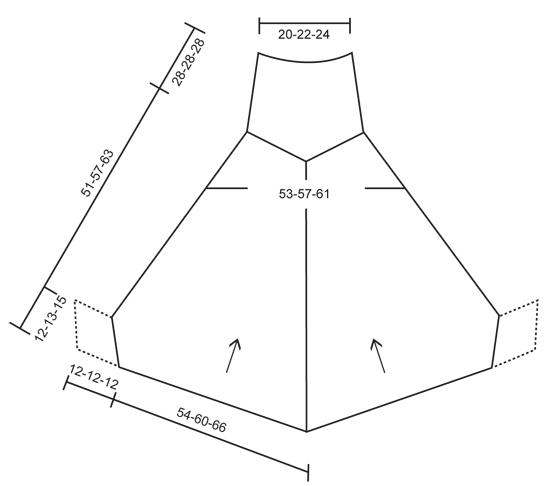
|
|
Have you finished this pattern?Tag your pictures with #dropspattern or submit them to the #dropsfan gallery. Do you need help with this pattern?You'll find 18 tutorial videos, a Comments/Questions area and more by visiting the pattern on garnstudio.com. © 1982-2025 DROPS Design A/S. We reserve all rights. This document, including all its sub-sections, has copyrights. Read more about what you can do with our patterns at the bottom of each pattern on our site. |
|








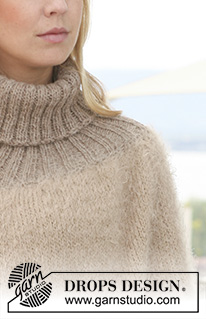


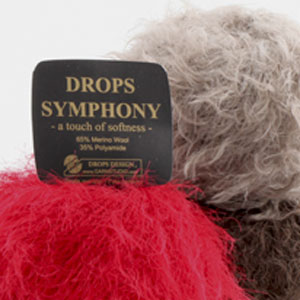























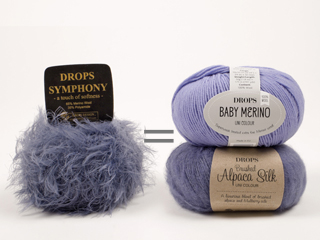
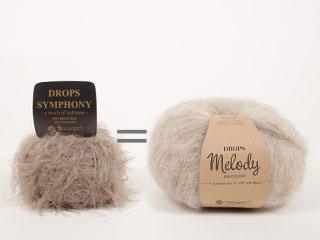

















Post a comment to pattern DROPS 123-28
We would love to hear what you have to say about this pattern!
If you want to leave a question, please make sure you select the correct category in the form below, to speed up the answering process. Required fields are marked *.